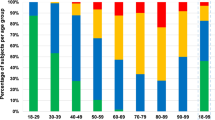Abstract
Relative to other sites, the cervical spine has received little attention in the osteoarthritis (OA) literature. Using data from a longitudinal study, we provide age-specific progression rates of radiographic cervical spine OA, by gender. Data from cohort subjects (ages 40+) from the Clearwater Osteoarthritis Study were analyzed (N = 707). All study subjects’ demonstrated radiographic cervical spine OA at baseline (2+). Lateral cervical spine radiographs were taken biennially. The study outcome was radiographic disease progression. A grade increase of 1, or more, by the Lawrence and Kellgren ordinal scale was considered progression. Incidence rates were calculated as per 100 person-years of observation. We show that the progression rates for cervical spine OA increase with age. For all ages combined, men demonstrated higher rates of progression compared with women. However, among subjects in their forties and fifties, women were more likely to experience worsening of their disease when compared with men. Progression rates were similar for men and women in their sixties (8.2 and 8.0, respectively). Among subjects in their seventies, men demonstrated a significantly higher rate of progression compared with women (12.5 and 8.6, respectively). As the baby-boomer population continues to increase, cervical spine OA progression assessment can be a useful tool for health-care resource planning. Cervical spine OA research offers an abundance of opportunities. Instability as a precursor to the development of cervical spine OA warrants further research. Epidemiological studies addressing demographic differences (e.g., gender, age) in the incidence of cervical spine OA will contribute to the current knowledge base.

Similar content being viewed by others
References
Daumen-Legré V, Lafforgue P, Champsaur P, Chagnaud C, Pham T, Kasbarian M, Acquaviva PC (1999) Anteroposterior atlantoaxial subluxation in cervical spine osteoarthritis: case reports and review of the literature. J Rheumatol 26(3):687–691
Snow RD, Scott WR (1994) Hypertrophic synovitis and osteoarthritis of the cervical facet joint: report of two cases. Clin Imaging 18(1):56–58
Mellem H, Johansen B, Nakstad P, Russell D, Seim H (1987) Unilateral phrenic nerve paralysis caused by osteoarthritis of the cervical spine. Eur J Respir Dis 71(1):56–58
Heathfield K (1973) Neurological complications of the rheumatic diseases. Rheumatol Rehabil 12(1):2–21
Holt S, Yates PO (1966) Cervical spondylosis and nerve root lesions. J Bone Joint Surg Am 48(3):407–423
Leonardi M, Simonetti L, Agati R (2002) Neuroradiology of spine degenerative diseases. Best Pract Res Clin Rheumatol 16(1):59–87
McCormack BM, Weinstein PR (1996) Cervical spondylosis: an update. West J Med 165(1–2):43–51
Kellgren JH, Lawrence JS (1963) Atlas of standard radiographs: the epidemiology of chronic rheumatism, vol 2. Blackwell Scientific, Oxford
Kelsey JL, Thompson WD, Evans AS (1986) Methods in observational epidemiology. Oxford University Press, New York, pp 290–292
Ozdemir F, Birtane M, Kokino S (2001) The clinical efficacy of low-power laser therapy on pain and function in cervical osteoarthritis. Clin Rheumatol 20(3):181–184
Trock DH, Bollet AJ, Markoll R (1994) The effect of pulsed electromagnetic fields in the treatment of osteoarthritis of the knee and cervical spine: report of randomized, double blind, placebo controlled trials. J Rheumatol 21(10):1903–1911
Gogia PP, Sabbahi MA (1994) Electromyographic analysis of neck muscle fatigue in patients with osteoarthritis of the cervical spine. Spine 19(5):502–506
Walz M, Auerbach F, Kolbow B (2006) Spondylosis hyperostotica: a rare cause of dysphagia, dyspnea, and neck-shoulder pain. Unfallchirurg 109(6):490–494
Heller JG (1992) The syndromes of degenerative cervical disease. Orthop Clin North Am 23(3):381–394
Macnab I (1975) Cervical spondylosis. Clin Orthop Relat Res 109:69–77
Rauoof MA, Lone NA, Bhat BA, Habib S (2004) Etiological factors and clinical profile of adhesive capsulitis in patients seen at the rheumatology clinic of a tertiary care hospital in India. Saudi Med J 25(3):359–362
Murtagh J (1990) The painful arm. Aust Fam Physician 19(9):1423–1426
Mata S, Fortin PR, Fitzcharles MA, Starr MR, Joseph L, Watts CS et al (1997) A controlled study of diffuse idiopathic skeletal hyperostosis: clinical features and functional status. Medicine 76(2):104–117
Dvorak J (1993) Neurological causes for wrist pain. Orthopade 22(1):25–29
Nakase H, Lida J, Matsuda R, Park YS, Sakaki T (2005) Clinical study of cervical myeloradiculopathy with carpal tunnel syndrome, double crush syndrome. No To Shinkei 57(10):883–887
Nakajima H, Uchida K, Oki H, Yayama T, Mwaka E, Kokubo Y, Sato R et al. (2009) Rapidly progressive neuropathic arthropathy of the knee in possible association with a huge extruded cervical intervertebral disc herniation. Rheumatol Int [Epub ahead of print]
Iwasa M (1976) Clinical analysis of angina pectoris and angina-like pain: with special reference to ECG during attack, “cervical spondylosis” and selective coronary arteriography. Jpn Circ J 40(10):1191–1203
Acknowledgments
The authors wish to thank Paul E. Leaverton, PhD for his review of the paper.
Conflict of interest statement
The authors declare that they have no conflict of interest.
Author information
Authors and Affiliations
Corresponding author
Rights and permissions
About this article
Cite this article
Wilder, F.V., Fahlman, L. & Donnelly, R. Radiographic cervical spine osteoarthritis progression rates: a longitudinal assessment. Rheumatol Int 31, 45–48 (2011). https://doi.org/10.1007/s00296-009-1216-9
Received:
Accepted:
Published:
Issue Date:
DOI: https://doi.org/10.1007/s00296-009-1216-9




